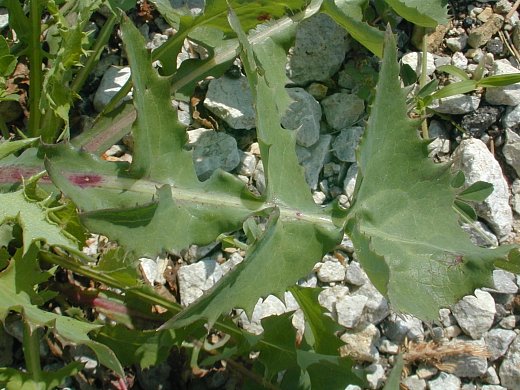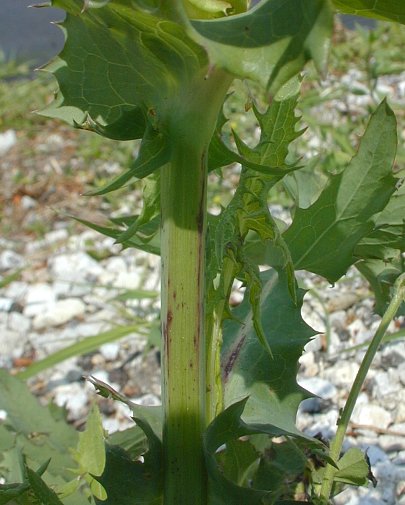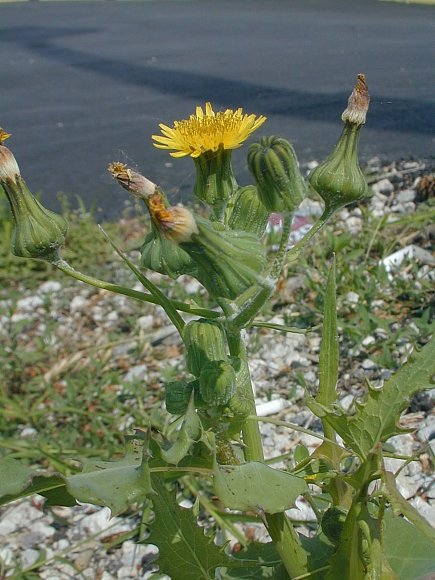Description: This plant is a winter or spring annual that is 1-4' tall, branching very little except near the apex where the flowerheads occur. The central stem is hairless and dull green; sometimes it is tinted with reddish purple. The alternate leaves are up to 8" long and 2¼" across, becoming smaller and more sparsely distributed as they ascend the central stem. Each leaf is odd pinnate (pinnatifid) with deep triangular lobes; its margins are dentate with soft prickles. The upper leaves are more likely to be entire or have shallow lobes. Like the central stem, each leaf has a dull green upper surface that is hairless; its base may be tinted reddish purple. At this base, there is a pair of pointed basal lobes that extend beyond the stem. The upper stems terminate in small clusters of flowerheads that are about ¾" across when they are fully open; these flowerheads bloom during the morning and close by noon.

Each flowerhead consists of numerous yellow ray florets and no disk florets. The floral bracts at the base of the flowerhead are dull green, hairless, and overlap each other in a vertical series. The blooming period occurs from late spring to mid-summer and lasts about a month in a given locale; a few plants may bloom later in the year. Each flowerhead is shortly replaced by numerous achenes with tufts of fluffy white hairs. Each dark achene is somewhat flattened, ribbed, and oblongoid; one end is somewhat broader than the other. Distribution of the achenes is by the wind. The root system consists of a stout taproot. The foliage contains a milky latex. This plant spreads by reseeding itself.

Cultivation:
This
adaptable plant is found in full or partial sun, moist to to slightly
dry sites, and soil that is somewhat fertile, consisting of loam or
clay-loam. It will grow in gravelly areas as well. The fertility of the
soil and moisture levels have a large impact on the size of this plant.
Range & Habitat:
Common Sowthistle is quite common in central and northern Illinois, but
less common or absent in the southern area of the state (see Distribution
Map). It is native to Eurasia and North Africa. Habitats
include fields, pastures, roadsides, gardens and edges of yards, vacant
lots, areas adjacent to buildings, construction sites, and waste
places. Disturbed areas are strongly preferred; Common Sowthistle
doesn't invade high quality natural areas to any significant degree.

Faunal Associations: According to Müller (1873/1883), Syrphid flies (including drone flies) feed on the pollen of the flowerheads, while White butterflies suck nectar. It is likely that various bees also visit the flowerheads. Occasionally, aphids suck on the plant juices of sowthistles (Sonchus spp.); they include such species as Hyperomyzus lactucae (Currant-Sowthistle Aphid), Hyperomyzus pallidus, Pemphigus bursarius (Poplar-Lettuce Aphid), Uroleucon sonchellum, and Uroleucon sonchi (Large Sowthistle Aphid). The larvae of several leaf-miner flies also feed on these plants, including Amauromyza maculosa, Chromatomyia lactuca, Chromatomyia syngenesiae (Chrysanthemum Leafminer), and Phytoliriomyza arctica. The larvae of Aulacidea tumida (Lettuce Tumor Gall Wasp) form galls along the stems, and Chortophaga viridifasciata (Green-striped Grasshopper) feeds on the foliage (Robinson & Bradley, 1965; Blackman & Eastop, 2013; Spencer & Steyskal, 1986; Felt, 1917; Wyoming Agr. Exp. Station, 1994). The foliage of sowthistles has a bitter milky sap; this reduces its attractiveness as a food source for mammalian herbivores. Nonetheless, the leaves, buds, and blossoms of these plants are eaten by the Franklin Ground Squirrel (Ostroff & Finck, 2003), and there is some evidence that White-tailed Deer browse on the mature flowerheads and spread the seeds to new locations (Myers et al., 2004). Among species of birds, there is evidence of only limited use of these plants. The Ruffed Grouse browses on the leaves, while the Eastern Goldfinch eats the seeds (Bennetts, 1900; Martin et al., 1951/1961).

Photographic
Location:
A gravelly bank near a parking lot in Urbana, Illinois.
Comments:
This is one
of three Sonchus spp. (Sowthistles) that is readily
observed in Illinois. The common name 'Sowthistle' is a misnomer
because this genus of plants is more closely related to the genus Lactuca
(Wild Lettuce). Both groups of plants have a milky latex, unlike true
thistles. The Common Sowthistle can be distinguished from Sonchus
asper (Prickly Sowthistle) by its foliage – the former has
dull green foliage with pairs of pointed lobes at the base of each
leaf, while the latter has shiny green foliage with pairs of rounded
lobes at the base of each leaf. Also, the leaves of Common Sowthistle
are more deeply lobed and triangular-shaped than the leaves of Prickly
Sowthistle. The other Sowthistle, Sonchus arvensis
(Perennial Sowthistle), has larger flowerheads (about 1-2" across) and
the lobes at the base of its leaves are small and rounded.